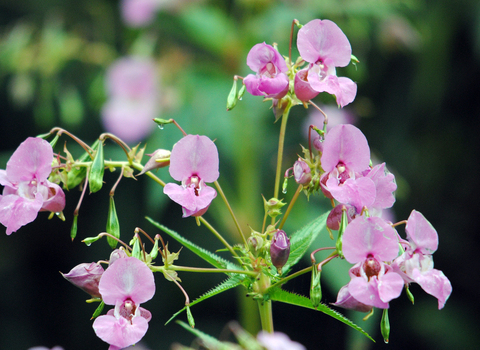
©Amy Lewis
Himalayan balsam
As its name suggests, Himalayan balsam is from the Himalayas and was introduced here in 1839. It now an invasive weed of riverbanks and ditches, where it prevents native species from growing.
Scientific name
Impatiens glanduliferaWhen to see
July to OctoberSpecies information
Category
Statistics
Height: up to 2mInvasive, non-native species.
About
Himalayan balsam was introduced as a garden plant in 1839, but soon escaped and became widely naturalised along riverbanks and ditches, especially close to towns. It is fast-growing and spreads quickly, invading wet habitat at the expense of other, native flowers. Its explosive seed pods aid its spread by sending the seeds into the river, causing further dispersal downstream.Our largest annual plant, it flowers from July to October.
How to identify
Himalayan balsam has large, pink flowers shaped like a bonnet; these are followed by hanging, green seed pods.Distribution
Found mostly in England, Wales and Northern Ireland, with some scattered populations in Scotland.Did you know?
Also known as 'Indian balsam', Himalayan balsam is originally from the Himalayas. This has earned it the charming nickname of 'Kiss-me-on-the-mountain' in some parts of the UK.
Me (middle) and friends from my Church community out pulling a large patch of Himalayan Balsam at Moss Bank Park in Bolton.
How to help tackle Himalayan balsam
Discover simple ways you and your local community can help protect your local wildlife by tackling Himalayan balsam.

Me (middle) and friends from my Church community out pulling a large patch of Himalayan Balsam at Moss Bank Park in Bolton.
How to help tackle Himalayan balsam
Discover simple ways you and your local community can help protect your local wildlife by tackling Himalayan balsam.
